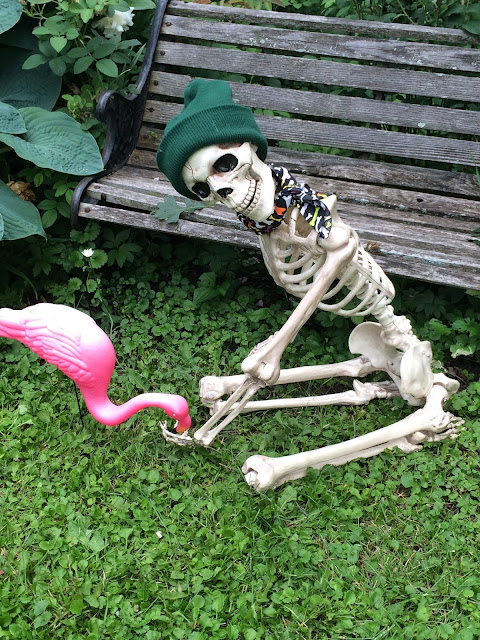This is a collection of the latest pinhole cameras being put to use in our household, they're made out of tape, rubber bands and the boxes from cereal and expensive gifts. Nick makes these cameras and uses them religiously. Every once in awhile I put away the digital equipment and pick up one of the pinhole cameras (he's been so nice to make for me) and try to portray the world a little bit differently.
So what do pinhole cameras have to do with anything? Well, our son Andy was going through our ancient collection of albums because apparently it's cool to listen to vinyl again. Naturally Burt had to
get in on the action, if only to add comic relief. Guess he's a closet Dead Head! Now we know.
The hunt through the vinyl set off a discussion on the pros and cons of digital music recordings, which eventually extended into photography. So the conclusion I came to is that pinhole cameras are sort of the vinyl of photography. Yes, it's a big stretch and I don't really think it's a good analogy but it did get me thinking about photos we all had taken without resorting to the digital realm.
The fact that most pinhole cameras are made from leftover stuff from around the house has always been amusing to me. They're green, too. So why stop at cardboard, since there is no lens involved it can be made out of just about anything, even Burt's head! Or maybe not, so onto some actual photos.
This is a photo I've taken dozens of times with a digital camera but last spring I gave it a try with a pinhole camera. Sometimes it produces a soft, almost dreamlike image. Many years ago, when Nick was teaching photography at Knox College, an artist named Ruth Thorne Thompson graciously agreed to come and hold a workshop on making and using pinhole cameras. She was a wonderful teacher and it was great fun learning how to take photos through a hole in a cardboard box! Naturally, once she was out the door, the magic wore off but the inspiration she gave us that day still remains.
Nick never lost the bug and has continued to make and use pinhole cameras ever since that workshop. In 2001 he joined in with some other like minded photographers who had instituted a Worldwide Pinhole Photography Day. This year it took place on April 26 with 3,450 people from 69 countries joining in. This is his photo of the tree we used to picnic under when we were in college.
This was the photo taken by Andy with his pinhole camera for WPPD 2014. He put the camera on the dashboard and opened up the sun roof while driving through suburban Boston that night.
In 2012 this was the first photo I took with my Chanel box camera. Most of the time I have no idea what I'm taking a picture of. Nick says that's the fun part of lensless photography. Okay.
The photo I submitted to WPPD this year was of the Magnolia tree in out front yard.
To be honest, it was the only one that turned out.
Needing all the help I can get to take pinhole photos, this app on my phone has been handy. It gives the exposure time or how long the shutter has to be open in order to get an image on the film. I accidentally captured the screen and recently found it in my camera roll. Isn't technology amazing?
This is the pinhole image I got.
As long as I had my phone out it seemed like a good time take a quick photo just in case the pinhole one was so blurry I couldn't tell what it was. After seeing them both together it kind of reminds me of what things look like when I put on my glasses first thing in the morning. Bit of a shock sometimes.
Of course there's always something to be shocked about, no matter how soft and fuzzy it looks.
Burt is really good at holding still during long exposures!
Thanks for coming along on the pinhole photography journey.
Do you remember listening to vinyl?
Did you ever make pinhole cameras at camp?
So glad you stopped by. Hope you are having a great weekend!


























































